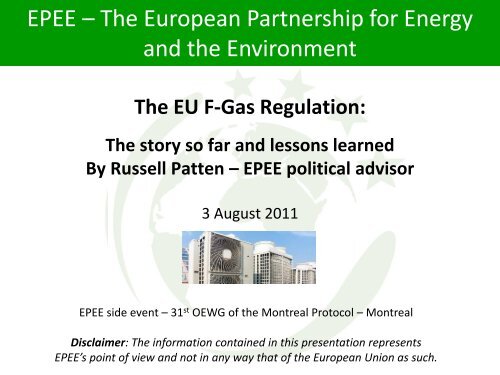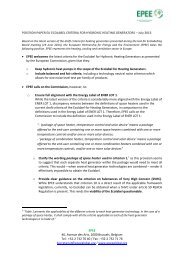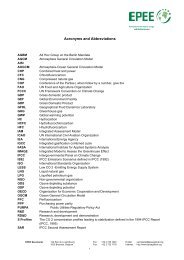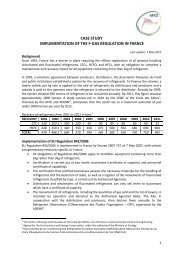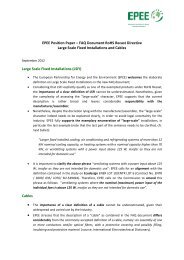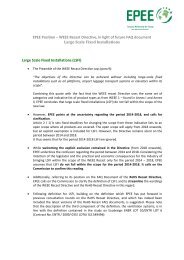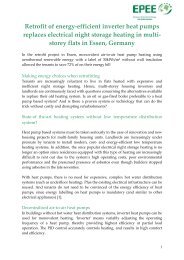The EU F-Gas Regulation - EPEE
The EU F-Gas Regulation - EPEE
The EU F-Gas Regulation - EPEE
You also want an ePaper? Increase the reach of your titles
YUMPU automatically turns print PDFs into web optimized ePapers that Google loves.
<strong>EPEE</strong> – <strong>The</strong> European Partnership for Energyand the Environment<strong>The</strong> <strong>EU</strong> F-<strong>Gas</strong> <strong>Regulation</strong>:<strong>The</strong> story so far and lessons learnedBy Russell Patten – <strong>EPEE</strong> political advisor3 August 2011<strong>EPEE</strong> side event – 31 st OEWG of the Montreal Protocol – MontrealDisclaimer: <strong>The</strong> information contained in this presentation represents<strong>EPEE</strong>’s point of view and not in any way that of the European Union as such.
<strong>The</strong> debate in the year 2000:A ban or a regulation on HFCs?In 2000, the EuropeanParliament and NGOs called fora ban on the use of HFCs:1. HFCs have a relatively highglobal warming potential(GWP)2. Alternatives exist:Ammonia, CO2,Hydrocarbons …3. Phase-out of ozone-depletingHCFCs leads to rapid increaseof HFCs<strong>The</strong> European Union finally decidedto regulate HFCs :1. HFCs offer major advantages:• Safety: low toxicity, non flammable, nohigh pressured installations required• Energy efficiency: Higher than that ofalternatives in numerous applications• Cost efficiency: No economically feasiblesolution for all applications2. Containment works:• Positive experience in the Netherlandswith STEK scheme.3. Refrigerant choice:• <strong>The</strong>re was no economical feasiblesolution for most applications and therewas/is no universal refrigerant:application, safety, climate conditions,energy efficiency, total climate impact,affordability …
<strong>The</strong> predecessor of the F-<strong>Gas</strong> <strong>Regulation</strong>:<strong>The</strong> Dutch STEK scheme, in place since 1992Higher productivity:Installers increase productivity ofown activities due to high qualityHVACR systemsCost savings:Refrigerant, spare part andenergy savings for owners dueto regular maintenanceHigher reliabilty:Manufacturers and installersincreased quality of equipment& serviceIncreased awareness:Industry and operatorsunderstand the environmentalimpact of HVACRReduced emission rates:From 20-25% to 3.5%Cost of STEK: <strong>EU</strong>R 0.33 / hour / service engineer
Containment & recovery• Preventive tightness checks:Frequency depends on the amount ofF-gas contained• Leak detection systems:For applications containing 300kg ormore of F-gases• Record keeping (logbooks)• Recovery, recycling ordestructionTraining and certification• Adequate training of personnelhandling F-gases• Mutual recognition in the <strong>EU</strong>• Minimum requirements onlyagreed upon in July 2007<strong>The</strong> F-<strong>Gas</strong> <strong>Regulation</strong>:Main requirementsReporting obligations• F-gas to be reported:with main categories ofapplications• Applies to:producers, importers and exportersof quantities > 1to• Member States to establishreporting systems.Labelling• For new equipment:Chemical abbreviation of F-gasWeight of the refrigerantKyoto protocol-coveredWhere applicable: product ishermetically sealed.• Further information in themanual (e.g. GWP)
It has already started to deliver !23 member stateshave set up trainingcentres21 member stateshave notifiedcertification bodies10 member states > 50%certified companiesBE (75%); CZ (74%); DE (66%);DK (100%); FR (62%); NL (100%);RO (53%); SK (67%); SI (84%);UK (75%)7 member states > 70%certified personnelBE (81%); CZ (74%); DE(75%); NL (99%); RO (75%);SK (87%); SI (78%)• > 20% emission ratereduction in the NL• Approx. 20% emissionrate reduction in theUK retail business• Increased awarenessof the need of tighterand better designedcomponents andconnections• Regular inspection andmaintenance acceptedas being necessary
A practical example onimplementation: Hungary• Hungarian Monitoring &Certification Body• > 7600 certified personel;1200 certified companies; >2000 registered operators; >22000 registered refrigerationcircuits• ODS and F-<strong>Gas</strong> regulationsmerged into one globalregistration and certificationsystem• Web-based registration andcertification system• Barcode-ID and circuit labelling• Online track-keeping of allservices (leakage checks,maintenance, etc.)
Support by voluntary industryinitiatives• FIGAROO – the F-<strong>Gas</strong> Regulatory Online Observatory. Developed by EFCTC Available in English, French, German, Italian, Spanish, Polish Information on the requirements under the F-<strong>Gas</strong> <strong>Regulation</strong>as well as a freely downloadable logbook for F-<strong>Gas</strong> users.• <strong>EPEE</strong> Frequently Asked Questions document Free of charge conferences in numerous Member States (i.e.Germany, Poland, the Czech Republic, Hungary) Regular exchanges of information with national governments.• National HVACR associations Leaflets and brochures Workshops and conferences Regular exchange of information with national governmentsAnd many more …
Support by the European Commission• Website:Development of a special section on the website ofDirectorate General Climate Action explaining HFCs and the<strong>Regulation</strong> in detail.• Sector specific leaflets:Including information on the obligations under the F-<strong>Gas</strong><strong>Regulation</strong>.• Speaking at national, European and international forums,NGO and industry events about the F-<strong>Gas</strong> <strong>Regulation</strong>, itsimplementation and its implications.
Lessons learned so far…1. Co-operation between national governmentsand the industry• A recipe for success (i.e. the UK, Hungary, Slovakia, theNetherlands).• It is essential to ensure that the obligations of the F-<strong>Gas</strong><strong>Regulation</strong> are communicated to all those affected and arebeing understood correctly.• <strong>The</strong> UK F-<strong>Gas</strong> Support is a prime example for successfulcommunication: removes hurdles and stimulates compliance2. <strong>The</strong> implementation of a complex piece oflegislation such as the F-<strong>Gas</strong> <strong>Regulation</strong> takestime:• It took 5 years for the STEK system to be fully understood andimplemented by all actors in the Netherlands. Several of theimplementing measures under the F-<strong>Gas</strong> <strong>Regulation</strong> (labelling,training) only entered into force in 2008.
Lessons learned so far…3. Containment works• Unfortunately there is a lack of available data -- littletime has passed since the implementation of the F-<strong>Gas</strong><strong>Regulation</strong>.• STEK showed a major improvement in leakage:From 25% emissions to 3,5% emissions in 7 yearstime with even lower emissions percentages knowntoday (in 2011, VRF systems in the Netherlandsreached less than 0.5% emissions).• AREA (contractors) /<strong>EPEE</strong> survey:When and where the F-<strong>Gas</strong> <strong>Regulation</strong> has beenimplemented correctly contractors observe a cleardecrease in refrigerant emission rates.• <strong>The</strong> F-<strong>Gas</strong> <strong>Regulation</strong> has clearly lead to betterawareness among users.
Lessons learned so far…4. <strong>The</strong> bigger picture…• <strong>The</strong> HVACR industry is extremely diverse:Any regulatory measure needs to take into account this diversity.• <strong>The</strong> choice of a refrigerant depends on a range of factors:Climate, application, energy efficiency, safety, cost, technical viability, direct and indirectemissions, etc.• Implementation takes time:<strong>The</strong> <strong>EU</strong> has 23 official working languages and 27 Member States with their own nationallegislative regimes.
Lessons learned so far…5. <strong>The</strong> F-<strong>Gas</strong> <strong>Regulation</strong> has boosted innovation• New alternatives have been developed (HFOs)• Improvements in HFC technology (lower GWP), e.g. cascades, micro-channel,etc.• Other sectors using HFCs are keen to be included under the F-<strong>Gas</strong> <strong>Regulation</strong> (i.e.refrigerated transport sector). Some countries have done so already (FR, NL, ES)
In Conclusion…• <strong>The</strong> Fgas <strong>Regulation</strong> is a great leap ahead, gathering momentum, but itneeds more time to deliver its full potential and it needs reviewing - don’tthrow the baby out with the bath water…• Let us learn from the very positive results to date and build on these…


